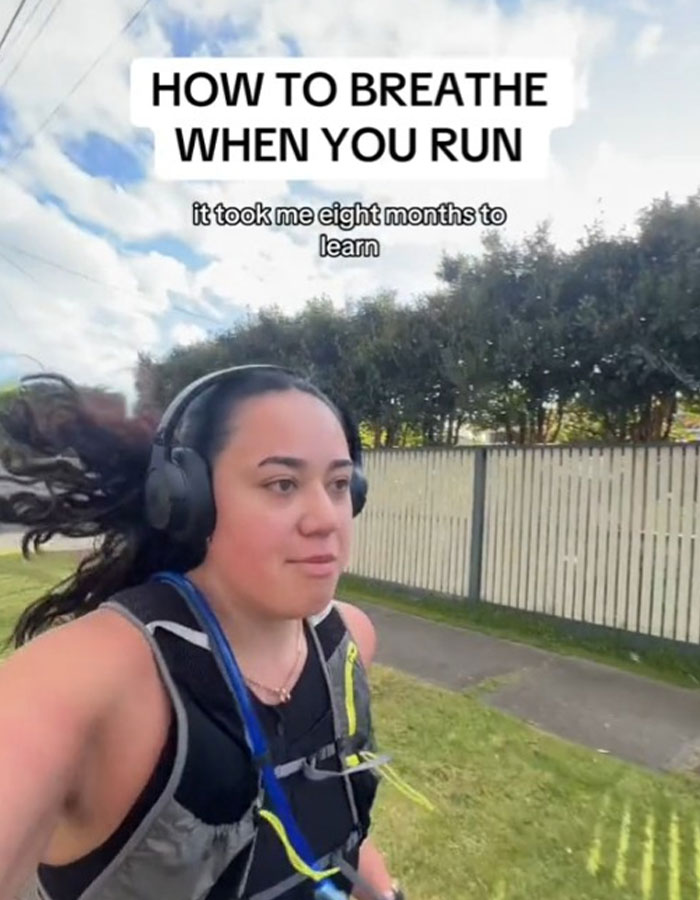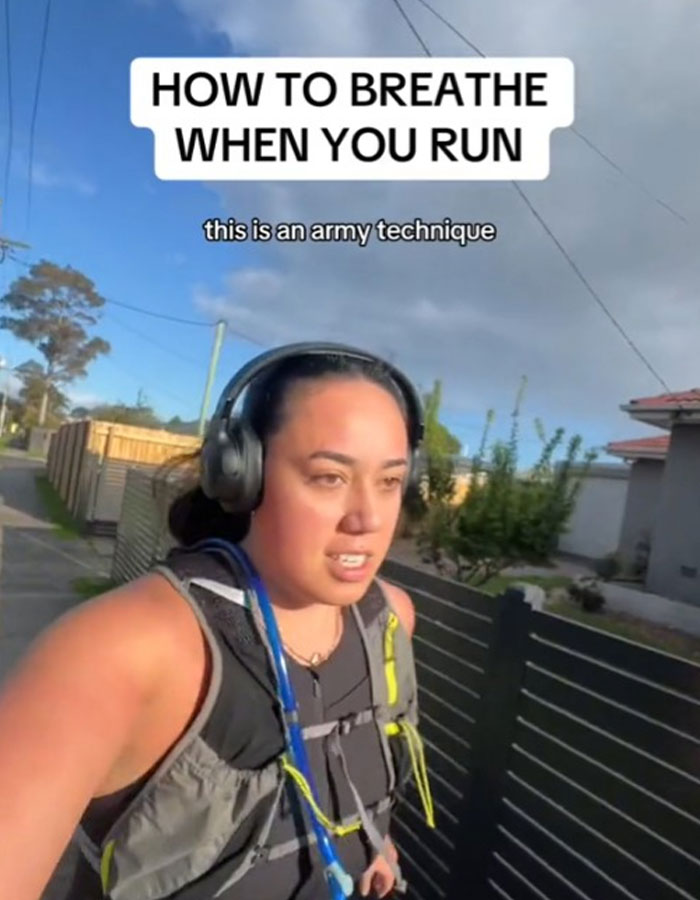
Runner Reveals “Army Breathing Technique” That Made Jogging Much Easier
Interview With ExpertControlling your breathing while running can make workouts more efficient, as demonstrated by a woman who shared an “army breathing technique” on social media.
Maraika Rose had beenrunning for eight months before discovering a way to make the activity less exhausting.
“Let me teach you. This is an army technique, so everything starts on your left foot,” the Polynesian runner began.
- Maraika Rose shared her "army breathing technique," which helps her run without getting out of breath.
- The runner's technique involves taking one deep breath in followed by two half breaths out.
- Rhythmic breathing aids oxygen circulation during exercise.
“You know how in the army they do ‘left, left, left, right, left,’ well, it’s a way of controlling their breathing.
“Every step, you’re doing something with your breathing. Essentially, what you’re doing is one deep breath in and then two half breaths out.”
Maraika Rose revealed her “army breathing technique” to make running easier in a viral video with over 3 million views

Image credits: maraika.rose
The content creator demonstrated her technique by controlling her breathing in sequences of three—in, out, out—while running on the streets of Melbourne.
“Controlling your breathing is the easiest way to keep yourheart rate down. Try it,” Maraika concluded.
“No one teaches you how you’re meant to breathe when you run and it took me sooooo long to find this technique and it’s made running A LOT easier!!!” she wrote in the video’s caption.
The runner controls her breathing in sequences of three—one deep breath in and then two half breaths out
Image credits: maraika.rose
In the comments, people responded to Maraika’sfitness hack, sharing their personal experiences with this type of physical activity.
“I feel like I’m not getting enough air in when I breathe like that,” one user wrote.
“Breathing isn’t an issue for me; it’s getting up to run,” another joked.
“I used to run 7-8km [4-5 miles] a day but started with 700m on day one lol. My mate who ran with me taught me this on day two, and this breathing technique is gold,” a third shared.
“I’m gonna try this cause I sound like I’m gasping for air,” somebody else added.
“When I was super fit I used this method, went from not being able to run to running 20km [12.4 miles] no problem,” said a separate user.
Watch Maraika’s method below
Creating a rhythm between breathing and the way in which you run, or establishing your gait, is a successful technique for runners, theAmerican Lung Association notes.
For more guidance on healthy breathing techniques during a jog, Bored Panda consulted Dr. Albert Rizzo, Chief Medical Officer for the American Lung Association.
“There are several theories on how to best breathe while running. One is called belly breathing or diaphragmatic breathing, which is the most immediate way to get more oxygen into the body,” Dr. Rizzo explained via email.
“Another way is rhythmic breathing. To practice rhythmic breathing, use belly breathing and a 5-step pattern: Three steps as you inhale and two steps as you exhale (i.e. as you step: inhale left, right, left; exhale right, left, right; inhale left, right, left; exhale right, left, right).
“This will naturally shift your breathing so it’s not impacting the same foot on the inhale repeatedly, reducing the pressure on the diaphragm and body during your run.”
As you run faster, you can shift to a 3-step pattern: two steps as you inhale and one step as you exhale.
Maraika had been running for eight months before discovering a technique that makes her workouts less exhausting and helps her avoid losing her breath
Image credits: maraika.rose
Image credits: maraika.rose
For optimal cardiovascular health, theCenters for Disease Control (CDC) recommends 150 minutes of moderate-intensity activity or 75 minutes of vigorous activity per week (or a combination of the two).
Instead of aiming for an intense run on a steep incline, it’s best to begin with a casual, comfortable jog and set realistic goals.
Take as many breaks as you need and control your breathing before increasing your pace.
TheCenters for Disease Control (CDC) recommends 150 minutes of moderate-intensity activity or 75 minutes of vigorous activity per week
Image credits: Pixabay
Image credits: Tirachard Kumtanom
Regular aerobic exercise like jogging can help you lose weight, strengthen your body’sresponse to illness (both in the short and long term),protect the brain from decline related to aging and stress, improve mental health byreducing levels of the stress hormone cortisol, and maintainspinal flexibility as you age.
Additionally, running is beneficial to lung health. “When you are physically active, your heart and lungs work harder to supply the additional oxygen your muscles demand. Just like regular exercise makes your muscles stronger, it also makes your lungs and heart stronger,” Dr. Rizzo said.
“As your physical fitness improves, your body becomes more efficient at getting oxygen into the bloodstream and transporting it to the working muscles. That’s one of the reasons that you are less likely to become short of breath during exercise over time.”
Before beginning any exercise routine such asrunning, it is important to speak with your healthcare provider. This particularly applies to individuals who may have a chronic condition such as asthma or chronic obstructive pulmonary disease (COPD).
“Learning such a technique must be a game-changer for runners,” a Facebook user wrote
TLDR: breathe in when your left foot touches the ground, and then exhale half the air when your left foot touches the ground again, and then exhale the second half when it touches the ground again. So to the rhythm of your left foot: IN out out IN out out IN out out IN out out. Like a 3/4 Walz or something (ONE two three ONE two three ONE two three IN out out. Interesting, will definitely try! Thanks Marina
A deliberate pick of an ambiguous word for clickbait - 'sick' can mean 'disgusting' or 'awesome' depending on context (and the generation of the speaker).
I have heard similar advice before on running forums. My usual rhythm is in-in-out-out. It does help stop the gasping.
TLDR: breathe in when your left foot touches the ground, and then exhale half the air when your left foot touches the ground again, and then exhale the second half when it touches the ground again. So to the rhythm of your left foot: IN out out IN out out IN out out IN out out. Like a 3/4 Walz or something (ONE two three ONE two three ONE two three IN out out. Interesting, will definitely try! Thanks Marina
A deliberate pick of an ambiguous word for clickbait - 'sick' can mean 'disgusting' or 'awesome' depending on context (and the generation of the speaker).
I have heard similar advice before on running forums. My usual rhythm is in-in-out-out. It does help stop the gasping.

 Dark Mode
Dark Mode 

 No fees, cancel anytime
No fees, cancel anytime 





























































25
6